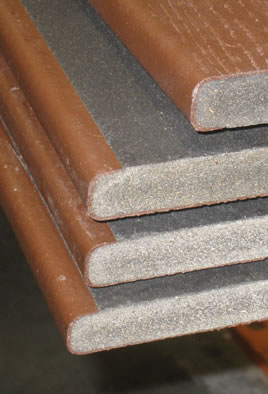Wood-plastic composites
Product description
Wood-plastic composites (WPCs) are non-structural materials made from wood residues and recycled plastic. WPCs can be produced to any shape and size, can be hollow core or solid, and can encompass curves or complex forms. In North America they are most often used outdoors as residential decks and railings, while in Europe they are used as automobile parts.

Technical information
Wood accounts for 30%–65% of finished WPC products by mass. Often recycled or recovered from sawdust, pulp fibres and other materials, such as bamboo and straw, the wood must be dried to 0.5% moisture content and used quickly before it reabsorbs moisture. It must also be ground to very small sizes to mix with the plastic, which is recycled or virgin, to produce a dough-like material. Various chemical additives may be incorporated to produce a material suited for specific end uses. The material is then either moulded or extruded to form solid or hollow-core shapes for specific products.
WPCs are relatively new materials with good moisture resistance, dimensional stability, exterior durability and high resistance to rot. They are considered to be relatively low maintenance, but their colours do fade because of sun exposure and they require periodic cleaning, often with a pressure washer. They are not as strong as solid or composite wood products.
Page details
- Date modified: